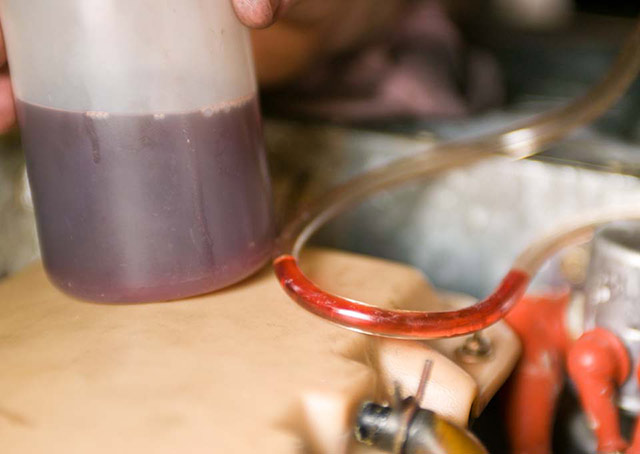Aircraft Maintenance: Bleeding brakes
Brake system basics and maintenance, part 4

The last part in our “brake odyssey” involves bleeding the brakes. Any time that you replace a component or fix a leak in the system, you must completely purge the system of air. This process is called “bleeding the brakes.”
Bleeding the brakes entails forcing new hydraulic fluid through the system, flushing out all of the air. Unfortunately, it’s not always as easy as it would seem. For one thing, aircraft designers are not known for their attention to maintenance access. For this reason, you may find that you’ll need one person under the panel at the brake pedals and another one down at the brake caliper. If you have a choice, choose to be the one outside the airplane. The guy under the panel often comes out cranky and covered in brake fluid!

Because air rises, the most effective way to flush the air out of the system is to force pressurized fluid up from the caliper, through the lines, and into the master cylinder. This process is usually done by attaching a “pressure pot” to the bleeder screw on each caliper. Of course, you’ll need a place for the excess fluid to go. If you have master cylinders with built-in reservoirs, you’ll need to attach a hose to the top of the cylinder at the fill hole. If you use a clear hose, you can watch the exiting fluid and see when there are no more bubbles coming out of the system. If your system has an external reservoir, there is no way to see when the air is out. You will have to force some fluid through the system, close the bleeder valve at the caliper, and test the brakes for a firm feel at the pedal. You also will need to watch the level in the reservoir carefully, siphoning off excess fluid before it overflows from the reservoir. This entire process will have to be done for both the left and right wheels.
Once the lines have been bled, re-seal the bleeder screw and remove the pressure pot. Then, before putting everything away, test the brakes multiple times to ensure that they are firm and no air is left in the system. Sometimes you may need to bleed a system more than once to get out all of the air. If repeated attempts still leave air in the system, you may need to bleed fluid from many different points in the system. This task can be done by bleeding through hose fittings, one at a time, while the system is under pressure. Carefully loosen each fitting until fluid starts to leak out, let enough fluid flow to force any trapped air out of the joint, and re-tighten the fitting. High points in the brake system are often the most challenging areas to purge completely.
Remember, getting the aircraft safely stopped is as important as getting it into the air. With a good dose of preventive maintenance, the braking system can be one of the most reliable systems on your aircraft. Happy flying!
Interested in aircraft maintenance? View the archives of Jeff Simon’s Aircraft Maintenance series.
 Jeff Simon is an A&P mechanic, pilot, and aircraft owner. He has spent the last 14 years promoting owner-assisted aircraft maintenance as a columnist for several major aviation publications and through his how-to DVD series: The Educated Owner. He is also the creator of SocialFlight, the free mobile app and website that maps over 20,000 aviation events, airport restaurants, and educational aviation videos, including many how-to videos for the subjects of these articles. Free apps are available for iPhone, iPad, and Android, and at www.SocialFlight.com.
Jeff Simon is an A&P mechanic, pilot, and aircraft owner. He has spent the last 14 years promoting owner-assisted aircraft maintenance as a columnist for several major aviation publications and through his how-to DVD series: The Educated Owner. He is also the creator of SocialFlight, the free mobile app and website that maps over 20,000 aviation events, airport restaurants, and educational aviation videos, including many how-to videos for the subjects of these articles. Free apps are available for iPhone, iPad, and Android, and at www.SocialFlight.com.



